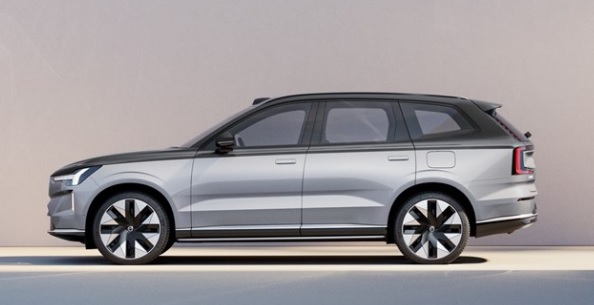Key specs
Volvo EX90 (SUV) EX90 2023,2024,2025,2026
What is the body type, Volvo EX90 111 kWh (408 Hp) Twin Motor 2023?
SUV, 5 Doors, 7 Seats
How fast is the car, Volvo EX90 111 kWh (408 Hp) Twin Motor 2023?
180 km/h 112 mph
How many cylinders, Volvo EX90 111 kWh (408 Hp) Twin Motor 2023?
Electric,
What is the drivetrain, Volvo EX90 111 kWh (408 Hp) Twin Motor 2023?
All wheel drive (4x4),
How long is this vehicle, Volvo EX90 111 kWh (408 Hp) Twin Motor 2023?
5037 mm
198.31 in.
How wide is the vehicle, Volvo EX90 111 kWh (408 Hp) Twin Motor 2023?
1964 mm
77.32 in.
What is the curb weight, Volvo EX90 111 kWh (408 Hp) Twin Motor 2023?
2818 kg
6212.63 lbs.
Volvo EX90 (SUV) EX90 2023,2024,2025,2026 Specs
General information
| Brand |
Volvo |
| Model |
EX90 (SUV) |
| Version |
EX90 |
| Engine version |
111 kWh (408 Hp) Twin Motor |
| Year production start |
2023 |
| Vehicle type |
SUV |
| Acceleration 0 - 100 kmh sec |
5.9 sec |
| Curb weight kg -lbs total |
2818 kg
6212.63 lbs.
|
| Overall length mm - inch |
5037 mm
198.31 in.
|
| Doors |
5 |
| Top Speed |
180 km/h 112 mph |
| Model summary-15 |
Twin Motor (EV) |
| Model summary-16 |
Electric motor front/rear |
Engine specs
| Cylinders |
Electric |
| Weight / horsepower kg/hp - hp/tons |
6.9 kg/Hp
144.8 Hp/tonne
|
| Weight / torque kg/Nm - Nm/tons |
3.7 kg/Nm, 273.2 Nm/tonne
3.7 kg/Nm
273.2 Nm/tonne
|
| Fuel type |
Electricity |
| Battery |
Type CATL
|
| Powertrain architecture |
BEV (Electric Vehicle) |
| Electric motor power |
245 Hp
|
| Electric motor torque |
420 Nm 309.78 lb.-ft.
|
| Total available power |
408 Hp
|
| Totale available torque |
770 Nm 567.92 lb.-ft.
|
| Eng 56 |
Battery -111 kWh
|
| Eng 57 |
Electric unit layout - Front axle, Transverse
|
| Eng 59 |
Charging DC 250 KW 30 min
|
Transmission and Drive system
| Drive configuration |
All wheel drive (4x4)
|
Brakes
| Front brakes |
Ventilated discs, 400x38 mm |
| Rear brakes |
Ventilated discs, 390x25 mm |
| Anti-lock brake system |
ABS (Anti-lock braking system) |
Steering
| Steering type |
Steering rack and pinion |
| Turning diameter m - ft |
11.8-12.2 m
38.71 - 40.03 ft.
|
Suspension
| Front suspension |
Spring Strut, Double wishbone, Transverse stabilizer, Air suspension |
| Rear suspension |
Spring Strut, Independent multi-link suspension, Air suspension |
Passenger
| Passengers seats |
7 |
| Head room front |
1122 mm |
| Leg room front |
1039 mm |
| Leg room rear |
926 mm second row, 811 mm third row |
| Hip room front |
1422 mm |
| Hip room rear |
1434 mm second row, 1096 mm third row |
| Trunk space min liter | cu. Ft. |
310 l
10.95 cu. ft.
|
| Trunk space max liter | cu. Ft. |
1915 l
67.63 cu. ft.
|
| Roof load load kg lbs |
100 kg
220.46 lbs.
|
Dimensions
| Overall length mm - inch |
5037 mm
198.31 in.
|
| Overall width mm -inch |
1964 mm
77.32 in.
|
| Overall height mm -inch |
1744 mm
68.66 in.
|
| Wheelbase mm - inch |
2985 mm
117.52 in.
|
| Track width front mm - inch |
1673-1678 mm
65.87 - 66.06 in.
|
| Track width rear mm - inch |
1667-1678 mm
65.63 - 66.06 in.
|
| Coefficient of drag |
0.29
|
| Dimensions-168 |
ground clearance standard 205 mm |
Weights
| Curb weight kg -lbs total |
2818 kg
6212.63 lbs.
|
| Weights-178 |
max towing capacity 2200 kg |
Fuel economy
| Fuel economy-190 |
Autonomy WLTP 600 km 372.82 mi |
Engine type
Electric
https://www.thecarspec.com/components/engine/electric

